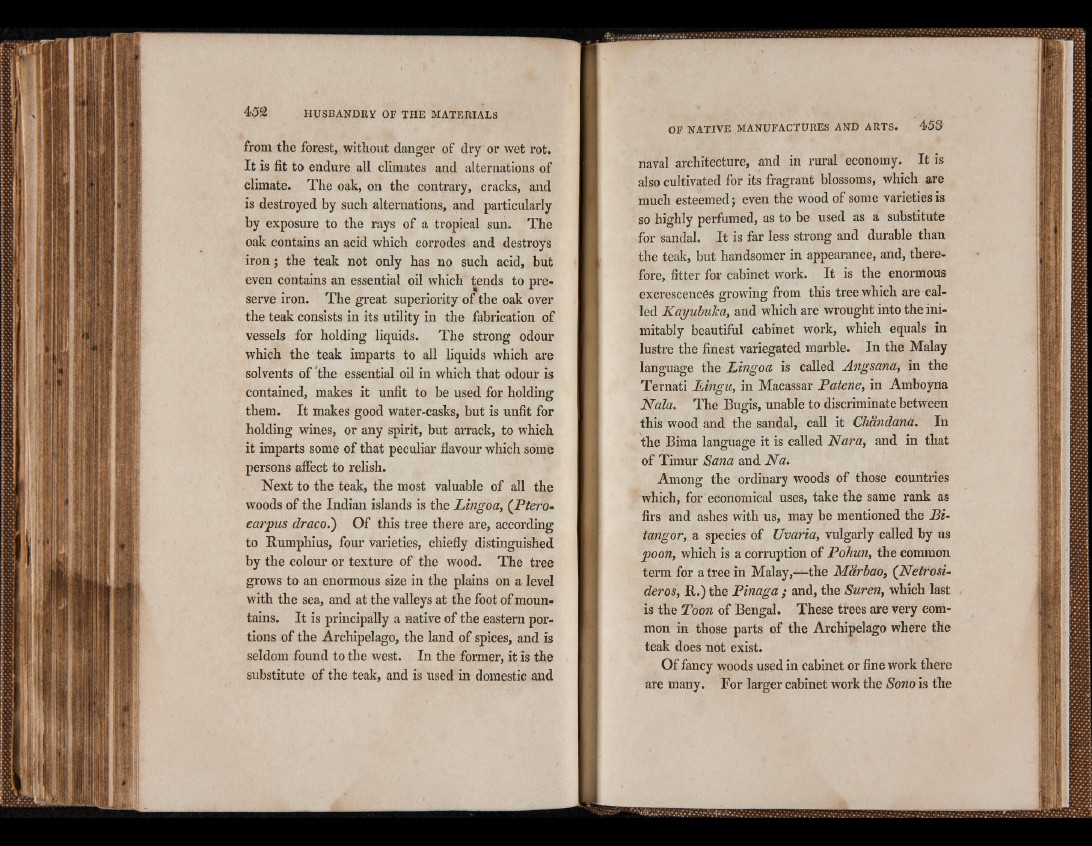
from the forest, without danger of dry or wet rot.
It is fit to endure all climates and alternations of
climate. The oak, on the contrary, cracks, and
is destroyed by such alternations, and particularly
by exposure to the rays of a tropical sun. The
oak contains an acid which corrodes and destroys
iron; the teak not only has no such acid, but
even contains an essential oil which tends to preserve
iron. The great superiority of the oak over
the teak consists in its utility in the fabrication of
vessels for holding liquids. The strong odour
which the teak imparts to all liquids which are
solvents of the essential oil in which that odour is
contained, makes it unfit to be used for holding
them. It makes good water-casks, but is unfit for
holding wines, or any spirit, but arrack, to which
it imparts some of that peculiar flavour which some
persons affect to relish.
Next to the teak, the most valuable of all the
woods of the Indian islands is the Lingo a, (Ptero-
carpus draco.') Of this tree there are, according
to Rumphius, four varieties, chiefly distinguished
by the colour or texture of the wood. The tree
grows to an enormous size in the plains on a level
with the sea, and at the valleys at the foot of mountains.
It is principally a native of the eastern portions
of the Archipelago, the land of spices, and is
seldom found to the west. In the former, it is the
substitute of the teak, and is used in domestic and
naval architeieture, and in rural economy. It is
also cultivated for its fragrant blossoms, which are
much esteemed; even the wood of some varieties is
so highly perfumed, as to be used as a substitute
for sandal. It is far less strong and durable than
the teak, but handsomer in appearance, and, therefore,
fitter for cabinet work. It is the enormous
excrescences growing from this tree which are called
Kayubulca, and which are wrought into the inimitably
beautiful cabinet work, which equals in
lustre the finest variegated marble. In the Malay
language the Lingo a is called Angsana, in the
Ternati Lingu, in Macassar Patene, in Amboyna
Nala. The Bugis, unable to discriminate between
this wood and the sandal, call it Chandana. In
the Bima language it is called Nara, and in that
of Timur Sana and Na.
Among the ordinary woods of those countries
which, for economical uses, take the same rank as
firs and ashes with us, may be mentioned the Bi-
tangor, a species of Uvaria, vulgarly called by us
jpoon, which is a corruption of Pohun, the common
term for a tree in Malay,—the Marbao, (Netrosi-
deros, R.) the Pinaga ; and, the Suren, which last
is the Toon of Bengal. These trees are very common
in those parts of the Archipelago where the
teak does not exist.
Of fancy woods used in cabinet or fine work there
are many. For larger cabinet work the Sono is the